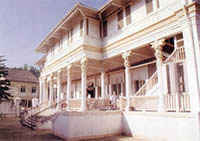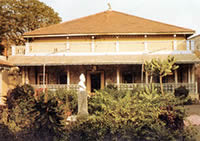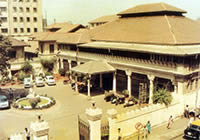Atash Behrams in India

The Fire Temples are divided into 3 grades. The Fire belonging to the first grade is that enshrined in an Atash Behram, the second is the Fire of the Adarian and the third is the Dadgah Fire. There are 8 Atash Behrams in India, the most sacred being the Iranshah at Udvada. Among others, one is in Navsari, two are in Surat and four are in Mumbai. The dates of the enshrinement of these eight Atash Behrams are :
| Name of Atash Behrams | City | Date of Consecration |
|---|---|---|
| Iranshah Atash Behram | Udvada | A.Y. 9.9.90 (A.C. 721) |
| Anjuman Atash Behram | Navsari | A.Y. 17.2.1135 (A.C. 1765) |
| Dadiseth Atash Behram | Mumbai | A.Y. 17.1.1153 Kadmi (A.C. 1783) |
| Modi Atash Behram | Surat | A.Y. 17.2.1193 (A.C. 1911 1823) |
| Vakil Atash Behram | Surat | A.Y. 3.3.1193 Kadmi (A.C. 5.12.1823) |
| Wadiaji Atash Behram | Mumbai | A.Y. 17.2.1200 (A.C.17.11.1830) |
| Banaji Atash Behram | Mumbai | A.Y. 17.4.1215 (A.C.13.12.1845) |
| Anjuman Atash Behram | Mumbai | A.Y. 3.2.1267 (A.C.17.10.1897) |
An Atash Behram fire is consecrated through an elaborate series of rituals during which the hifhest laws of purity are maintained by the priests involved in the process. The bringing together of the 16 Fires representing the natural order as well as the different trades and classes of ancient Iranian society, reflects the universality of the Atash Behram Fire. The Fire of lightning, for example, is collected when lightning strikes the earth and is witnessed by two Zoroastrians; whilst the 16th fire, the household fire of a Zoroastrian, is made by the priest by first creating a fire through friction using flint stones or twigs and then mixing it with fire from the hearth of a Behdin.
The sixteen Fires required for the consecration of an Atash Behram (Fire of Victory) are as under :
| Fire of - | No. of Times for * the Collection * Purification * Consecration Process |
Names of Yazatas in whose honour three Yasna & Vendidad are recited for the first three days. |
|---|---|---|
| 01. A burning Corpse | 91 | Ahura Mazda |
| 02. Dyer | 80 | Bahman |
| 03. King or ruling authority | 70 | Ardibehesht |
| 04. Potter | 61 | Shehrevar |
| 05. Brick Maker | 75 | Asfandarmard |
| 06. Ascetic | 50 | Khordaad |
| 07. Goldsmith or (Alchemist) | 60 | Amardaad |
| 08. Mint | 55 | Dae-padar |
| 09. Ironsmith | 61 | Adar |
| 10. Armourer | 61 | Avan |
| 11. Baker | 61 | Khorshed |
| 12. Brewer, Distiller or Idol Worshipper | 61 | Mohor |
| 13. Soldier or Traveller | 35 | Tir |
| 14. Shepherd | 33 | Gosh (Dravasp) |
| 15. Atmospheric Electricity | 90 | Daepmeher |
| 16. Zoroastrian, i.e. a Dastur (Head priest) Mobed (Priest) or a layman and of friction by flint and pieces of wood | 40+144 = 184 | Meher |
| Total = 1,128 | Times Yasna and Vendidad are recited |
Source : A Brief History of Anjuman Atash Behram – Mumbai (1897-1996) reproduced with the kind permission of Dasturji Dr. K. M. JamaspAsa); Global Directory Of Zoroastrian Fire Temples - Marzban J. Giara

This sacred fire has an 'aura' which attracts each and every Zoroastrian to it like a magnet. It is the most sacred of all fires in India and is known by its honorific title of Iranshah (King of Iran).
| Address Iranshah, Udvada Town, Udvada Pin 396 180, Gujarat State. |
| Date Consecrated Roz Adar, Mah Adar, 90 A.Y., 721 A.C. at Sanjan |
Short History:
After five years of settling peacefully in Sanjan in 90 A.Y., Dasturji Nairyosang Dhaval requested Jadi Rana for land and permission to consecrate an Atash Behram. The noble King granted permission and gifted the land. The Divine Alat was brought from Khorasan, Iran. On Roj Adar, Mah Adar by his spiritual power, Dasturji Nairyosang Dhaval created a pav mahal and brought down the lightning fire and established the sacred Iranshah Atash Behram on the sacred soil of India at Sanjan in Gujarat 721. A.C.
Iranshah's Journey:
| Sanjan | 669 years |
| Bahrot Caves | 13 years (1393 - 1405 A.C.) |
| Vansda Jungles | 14 years (1405 - 1418 A.C.) |
| Navsari | 313 years (1419 - 1732 A.C.) |
| Surat | 3 years (1733 - 1736 A.C.) |
| Navsari | 5 years (1736 - 1741 A.C.) |
| Valsad | 1 year (1741 - 1742 A.C.) |
| Udvada | 273 year (28-10-1742 - till date) |

| Address Tarota Bazar, Navsari Pin - 396 445, Gujarat State. |
| Date Consecrated Roz Sarosh, Mah Ardibehest, 1135 A.Y., 02-December-1765. |
Short History:
This Atash Behram is probably the most picturesque in India. The beautiful and well maintained garden in the foreground together with the Achemenian style of architecture lifts up one's spirit. The first Dasturji Meherjirana's natural silhouette in the marble slab opposite the holy 'kebla' bears an uncanny resemblance to the Dastur's traditional straight posture.
During the period, 1400 to 1500 A.C. the illustrious Parsi leader Changasha had great impact on Navsari. Navsari was then known as 'Parsi puri'. The poet Jehangir Desai has referred to Navsari as the twon that is the birthplace of great man, such as First Dastur Meherji Rana, Dastur JamaspAsa, Khurshedji Tehmulji Desai, Sir Jamsetjee Jeejeebhoy, Jamsetjee Tata, Dadabhai Naoroji and Shapoorji Fakiriji Jokhi.
It is well known that Changasha, the illustrious leader of Navsari Parsis brought Iranshah from Vansda to Navsari in 1419 A.C. Due to differences between the Sanjana and Bhagaria priests in 1741 A.C. the sacred Iranshah fire was taken from Navsari to Valsad and then settled at Udvada. To satisfy their religious and spiritual hunger the Parsis of Bhagarsath Anjuman decided after 24 years to establish an Atash Behram.
Dastur Sorabji Rustamji Meherjirana selected a hundred wise and pious mobeds. On Roz 1 Hormuzd, Mah 4 Teshtar Tir, 15th January 1765, they started the work of consecrating the Atash Behram.
This sacred fire of the Atash Behram was consecrated on Roz Sarosh Mah Ardibehesht 1135 A.Y., Monday 2nd December 1765 A.C., under the leadership and assistance of Desaiji Shri Khurshedji Tehmulji by the Bhagarsath Anjuman fo rthe continuance of its 'Panthak'. The consecration ceremony was performed by Dasturji Sorabji Rustamji Meherjirana, the seventh descendant of the ancient linage of First Dastur Meherjirana. He also performed the first buoi ceremony.

| Address Sayyadpura, Bhagol, Surat Pin- 395 003, Gujarat State. |
| Date Consecrated Roz Sarosh, Mah Ardibehest, 1193 A.Y., 19-November-1823. |
Short History:
The Parsis had inhabited Surat for 300 years since the 16th - 17th century and were prosperous in trade, commerce and agriculture. The devout Zoroastrians yearned for establishig an Atash Behram. Sheth Dadabhai Naoshirwanji Modi died in 1810 at the young age of 51 years. To keep his memory evergreen, his old mother decided to establish an Atash Behram at their native place at Surat. Sheth Dadabhai's widow, Bai Jaijee, grand-daughter of Sheth Lovjee Wadia completed this noble work with the help of her brother, Sheth Hormusji Bomanji Wadia of Bombay.
The lightning fire for this Atash Behram was obtained from Calcutta. Seth Hormusji Wadia wrote to his Calcutta agent Seth Navroji Sorabji Umrigar to obtain the lightning fire. Seth Rustamji Cawasji Banaji had a press at one end of Calcutta where his friends gather every Sunday. On 04-05-1823 six of them were seated on teh river bank when there was a sudden storm at 5.45 p.m. and lightning strck. There were banana trees in the garden. The dry part caught fire. Seth Navroji Sorabji himself carried the burning stem home and offered sandalwood and incense. He carefully preserved the fire and sent it to Bombay by ship which two Parsi caretakers.
The Atash Behram was consecrated on 19-11-1823. That day has gone down in history for three important recored. (1) 20,000 Parsis from all over India came to attend the opening religious ceremony. (2) For the first time in history of Surat, all Government offices, factories and small industries were declared closed and the occasion was celebrated by all. (3) Davar Khurshedji Dassabhoy Modiji, the then Head of the PArsis, was carried in a palanquin from his residence to the fire temple in a procession of all communities including the staff of the Sadar Adalat, Jilla Adalat, Military garrison, men of the Collectorate, Bakshi of Surat and military and other bands.
The consecration ceremonies started on Roz 12 Mah 2, 1192 A.Y. and went on for twelve months.Dasturji Edulji Sanjana went to Surat on Roj 16, Mah 9, 1191 A.Y. He played a leading role in consecrating the fire. He stayed in Surat for 17 months.
The Atash Behram was constructed at a total cost of about a lac of rupees out of the monies left by Sheth Dadabhai. The consecration ceremonies lasted over a year under the guidance pf Dasturji EduljiDarabji Sanjana of Bombay. The first buoi was performed by Dasturji Kaikhushru Dadabhai of Surat.

| Address Shahpore, Surat Pin- 395 003, Gujarat State. |
| Date Consecrated Kadmi - Roz Ardibehest, Mah Teshtar Tir, 1193 A.Y., 05-December-1823. Shehenshahi - Roz Ardibehest, Mah Khordad, 1193 A.Y., 05-December-1823. |
Short History:
Sheth Pestonji Kalabhai Vakil became a famous lawyer. Once when he fell seriously ill, he wished that when he recovered, he would establish a Kadmi Atash Behram. In 1819 the Wadias and Modis filed case against Pestonji Vakil to restrain him from building a Kadmi Atash Behram. In 1822, the court decided in favour of Pestonji Vakil.
The Atash Behram was consecrated on Roz 3 Ardibehesht, Mah 4 Teshtar Tir (Kadmi), 1193 A.Y. 05-12-1823 A.C. at Shahpore, Surat. The consecration ceremonies were performed by Dasturji Sorabji Jamshedji Nalladaru who was a scholarly, pious dastur, along with Dasturji Sorabji Rustamji Kumana. Sorabji Nalladaru has the honour of performing the first buoi.
Lighning struck a tree at Surat when the court case was in progress. After obtaining the court's permission the lightning fire was collected and used for establishing the Atash Behram.

| Address Dadiseth Agiary Lane, Fanaswadi, Dhobi Talao, Mumbai - 400 002. |
| Date Consecrated Kadmi - Roz Sarosh, Mah Farvardin, 1153 A.Y., 29-September-1783. Shehenshahi - Roz Govad, Mah Aspandad, 1153 A.Y., 29-September-1783. |
Short History:
It was the first Atash Behram in Mumbai. It was also the first Kadmi Atash Behram. The first Shehenshahi Atash Behram in Mumbai - Wadiaji's was built 47 years later. Seth Nosherwanji Dadiseth has established it.
The scenic garden land admeasuring 6,338 square yards was purchased and a large building erected at Dadiseth's own expense. On Roz 17 Sarosh Mah 1 Fravardin, Kadmi 1153 A.Y. (Shehenshahi Roz Govad, Mah Aspandad), 29-09-1783, A.C. under the leadership of Dastur Mulla Kaus Bin Rustam Jalal, the Atash Behram was consecrated with full faith and reverence. Dastur Mulla Kaus was the first 'Vada Dastur' of Kadmi sect. The first buoi was offered by him. He was the 24th descendant of Mobed Shapur Sheriar, through whom all mobeds in India trace their origin.

| Address Shamaldas Gandhi Marg, (Princess Street), Dhobi Talao, Mumbai - 400 002. |
| Date Consecrated Roz Sarosh, Mah Ardibehest, 1200 A.Y., 17-November-1830. |
Short History:
Seth Hormarjee Bomanjee Wadia had wished to build Atash Behrams in several parts in India.
As per his will and pious bequest, his sons Bomanjee, Rustomji and Ardeshir Hormarjee Wadia, decided at the earliest opportunity, to build an Atash Behram at Charni Wadi, the same place where 25 years ago, their illustrious father had built the Atash-e-Adaran for the benefit of the Parsees of that locality. The total population of Bombay, then was 10,738. While in the vicinity of the Adaran, 1074Parsees were living.
The Atash Behram is located on a free-hold land of 4493 4/9 square yards.
The consecration ceremonies took place on Roz 17, Mah 2nd, Shehenshahi 1200 A.Y., 17-November-1830 A.C. Dastur Edulji Darabji Rustomji Sanjana performed the ceremonies and, he was the first Dasturji to offer 'Buoi' on that memorable and auspicious day.

| Address Thakurdwar Road, Mumbai - 400 004. |
| Date Consecrated Kadmi - Roz Sarosh, Mah Teshtar Tir, 1215 A.Y., 13-December-1845 A.C. Shehenshahi - Roz Sarosh, Mah Khordad, 1215 A.Y., 13-December-1845 A.C. |
Short History:
For one year eejashne-vendidad religious rituals were performed for consecrating the Atash Behram under the leadership of Dasturji Jamshedji Edulji Jamaspasa (of Shehenshahi sect) and Dasturji Bejonji Rustamji (Bejandaru of Kadmi sect). Vada Dasturji Bejonji Rustamji of Kadmi sect offered the first buoi. It is said that 16,000 Parsis were present at the celebrations. The Banaji brothers spent Rs. 1.5 lakhs for consecrating the Atash Behram.

| Address J. Sankersheth Road, Dhobi Talao, Mumbai - 400 002. |
| Date Consecrated Roz Ardibehest, Mah Ardibehest, 1267 AY., 17-October-1897 |
Short History:
The foundation-stone laying ceremony of this Atash Behram was formally performed by Dastur Dr. Jamaspji Minocherji JamaspAsa, M.A., Ph.D., D.C.L., on Roz Dae-pa-Adar Mah Ardibehest, 1267 A.Y., Sunday 17 October 1897.
The congregation inside the Atash Behram numbered about 10,000 persons. (Times of India of 18-10-1897).
The Total cost of building the Atash Behram amounted to about Rs. 2,25,000. The Bhagaria priests of Navsari, practising in Bombay, formed a committee under Dastur Jamaspji which carried out the formidable task of fulfilling their long-cherished wish to establish a second Bhagaria Atash Behram in Bombay. It is pertinent to note that Sheth Jalbhoy Ardeshir Sett, Chairman and Sheth Sohrabji Rustomji Bunshah, Honorary Secretary of the Atash Behram, played an important role in support of this sacred cause.
The collection of fetching, purifying and consecrating of the sixteen fires required was completed on Roz Aneran Mah Spandarmad 1266 A.Y. On the next day, the first Gatha day, the unison of the sixteen consecrated fires took place. The sacred Fire was kept then in a separate roon in a smaller censer covered with a lid. In the days to come, the consecration of the united fire and of the 'gumbad' (sanctum sanctorum) itself was completed. On the day of the enthronment, a final Yasna was performed and the small censer containing the fire covered with a lid was then taken in a procession led by Dasturs and Mobeds from the Yazishn-gah to the 'gunbad'/ A consecrated path (pavi) was made between the two places in order to maintain the highest state of ritual purity and prefection. By 9.00 a.m., a procession was formed at the Yazishn-gah. In the front of the procession were twelve Mobeds carrying various implements like ladles, swords, spears and maces followed by the congregation. The small censer containing the fire was lifted by Dastur Kaikhusroo Jamaspji and Mobed Fardunji Edulji Vajifdar and the procession passed through seven doors, being cheered by all present, before reaching the 'gumbad'. Inside the chamber the small censer was placed next to the main one. Dastur Kaikhusroo Jamaspji recited an Ahunavar and while chanting the word shyaothananam, a small portion of the fire was lifted from the small censer and transferred in the main one with the help of a ladle. This process was repeated two times more till the small censer was completely empty. Then sandalwood was offered in the main censer and the implements were hung on the wall. The very first buoi ceremony was performed by Dastur Kaikhusroo Jamaspji.
